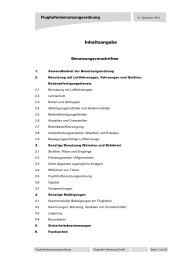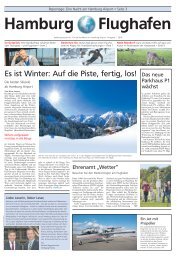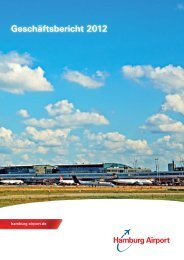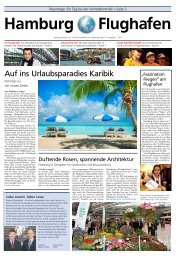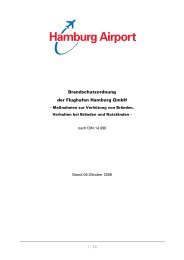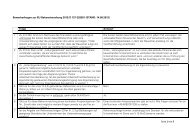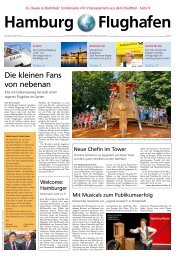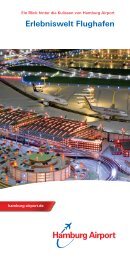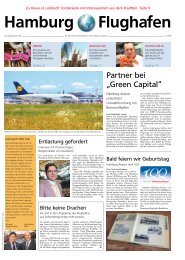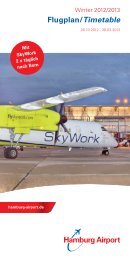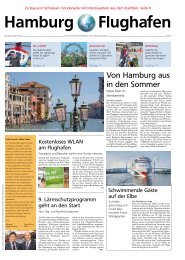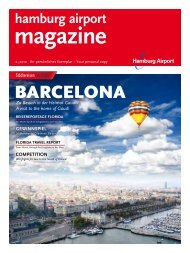Annual Report 2012 (PDF) - Hamburg
Annual Report 2012 (PDF) - Hamburg
Annual Report 2012 (PDF) - Hamburg
You also want an ePaper? Increase the reach of your titles
YUMPU automatically turns print PDFs into web optimized ePapers that Google loves.
Sustainable environmental action<br />
Technical innovations and new processes<br />
Sustainable environmental work is an established component of the company philosophy.<br />
<strong>Hamburg</strong> Airport’s Environmental Guidelines include the voluntary commitment to<br />
improving environmental protection. Programmes and measures arising from this commitment<br />
are subject to continual updating and adjustment. Beyond this, open and critical<br />
dialog with the general public along with the promotion of environmental awareness<br />
amongst employees are also part of <strong>Hamburg</strong> Airport’s proactive environmental<br />
policy. “Effective environmental protection for our inner-city airport incorporates the<br />
obligation to respond appropriately to the special demands of the location and the surrounding<br />
area,” emphasises Michael Eggenschwiler, CEO at <strong>Hamburg</strong> Airport.<br />
Award-winning: climate protection put into action at<br />
<strong>Hamburg</strong> Airport<br />
<strong>Hamburg</strong> Airport leads the way with its successful waste<br />
water handling, landscape care and noise-protection windows,<br />
all of which have been recognised according to international<br />
standards. The airport’s Environment Management<br />
System, certified according to EMAS (Eco Management<br />
and Audit Scheme) and ISO 14.001, systematically determines<br />
the environmental impact of airport operations in order<br />
to reduce or balance impact with environmental programmes.<br />
The current Environment Programme runs from<br />
2011 to 2014. The measures mandated therein are targeted<br />
at reducing <strong>Hamburg</strong> Airport’s carbon footprint by a total of<br />
5 percent in comparison to 2010.<br />
Thanks to its committed environmental work, <strong>Hamburg</strong><br />
Airport received Airport Carbon Accreditation in 2011. The<br />
airport had set out to achieve Level 2 accreditation (CO 2<br />
measurement and reduction) and producing less greenhouse<br />
gases in the future. “We have set ourselves a target<br />
of a 15 percent reduction in CO 2<br />
by 2020,” explains Axel<br />
Schmidt, Director of the Environmental Protection Centre at<br />
<strong>Hamburg</strong> Airport. <strong>Annual</strong> data must be recorded in order to<br />
fulfill the Airport Carbon Accreditation requirements. On the<br />
basis of these figures, a logical and effective concept has<br />
been put together to reduce CO 2<br />
emissions. <strong>Annual</strong> measurements<br />
of emission levels (carbon footprint) allow for regular<br />
assessment of the effectiveness of the concept, which<br />
is helping to identify solutions for alternatively powered<br />
vehicles.<br />
<strong>Hamburg</strong> Airport won the GreenFleet® Award <strong>2012</strong> for<br />
its pioneering economically and ecologically efficient fleet<br />
management last year. The award programme is operated<br />
by a subsidiary of TÜV SÜD. The current <strong>Hamburg</strong> Airport<br />
Group’s fleet consists of 42 biomethane tugs, six biomethane<br />
buses and 14 other biomethane vehicles. These vehicles<br />
are refuelled directly at the airport’s on-site facility. Other<br />
vehicles include one tug fitted with a fuel cell, two electric<br />
vehicles and two hydrogen-powered vehicles. The use<br />
of the hydrogen vehicles results in an annual saving of 528<br />
tonnes of CO 2<br />
.<br />
Heating levels have been lowered and air conditioning<br />
temperatures (cooling) raised as an operative climate<br />
protection measure. The thermolabyrinth under Terminal<br />
1 pre-warms and/or pre-cools the air, reducing the energy<br />
consumption of the air conditioning. The annual savings<br />
achieved here are approx. 400 tonnes of CO 2<br />
. The proportion<br />
of climate-neutral electricity in purchased electricity<br />
has also been doubled, and more eco-lightbulbs have being<br />
installed.<br />
Aircraft take the electricity they need, along with heating<br />
and air conditioning, from the airport’s supply lines at the<br />
Pier handling positions. The integration of the S-Bahn metro<br />
rail network into the transport mix (25 percent of passengers<br />
come by rail) has enabled the airport to record an annual<br />
saving of 577 tonnes of CO 2<br />
(in the airport vicinity).<br />
Passive and active noise protection to improve the<br />
noise situation<br />
Despite increased passenger numbers in recent years, the<br />
noise footprint has shrunk by around 40 percent since 1997,<br />
thanks to proactive environmental work. The airport has invested<br />
around 38 million euros in passive noise protection<br />
in the community over the past years, well beyond the legal<br />
requirement, aimed at sustainable safeguarding of the site.<br />
To date, the eight voluntary Noise Protection Programmes<br />
conducted by <strong>Hamburg</strong> Airport have resulted in over 15,000<br />
households being provided with noise-protection windows<br />
free of charge, and more than 9,300 soundproof ventilators<br />
have been installed. As part of the new legally mandated<br />
programme, which commenced with the definition of the<br />
new noise protection zones by the regulatory authority in<br />
the spring of last year, the airport is investing over 10 million<br />
euros to provide speedy assistance to additional affected<br />
parties. Active noise protection promotes the direct reduc-<br />
12



